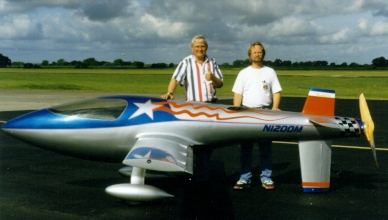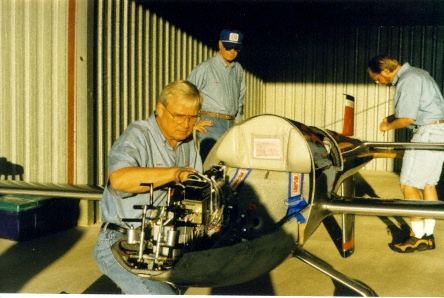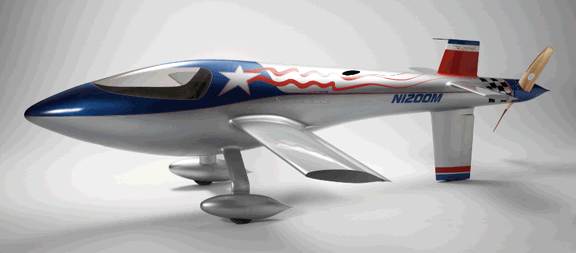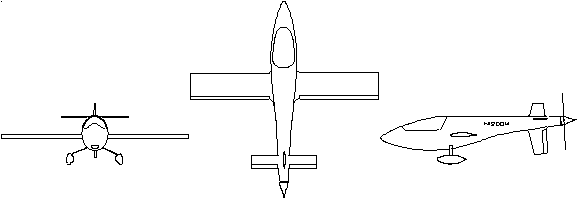Update June 3, 1997

Lars and Tom the day before the test flight.

Lars and Tom the day before the test flight.
The take off of the VmaxProbe was a wonderful sight to behold! She climbed like she knew she belonged in the sky. Lars continued to climb while he had good temps and power. The 2SI motor was a strong a thunderous sound. Lars radioed that the temperature was starting to climb, so he throttled back to let it stabilize and get a feel for the controls. Everything was going as planned. He had a chase plane go up after him. They radioed that "that thing is FAST".
After about 5 minutes of successful flying, Lars decided to bring her in. It was a picture perfect approach. About 1000 feet down the runway, he was holding her off at about 5 feet. Then something went wrong. The aircraft dropped abruptly, the left wingtip struck the ground and the aircraft rolled and struck the runway inverted.
Geneva and Tom were the first ones at the scene. Lars sustained a traumatic head injury and passed away at the hospital 6 hours later. He appreciated all the support you have given him and it was your support that helped make his dream possible.
This is the article that appeared in the Houston Chronicle.
|
9:20 PM 6/8/1997 Aviator killed in crash is remembered for his love of speed By STEVE OLAFSON Copyright 1997 Houston Chronicle
|

Lars and Tom making final checks for the test flight



![]()
 The VmaxPROBE was designed to be the ultimate low-drag, manned, piston-engine powered aircraft. It was built in Houston, Texas by the designer, Lars Giertz. After initial flight testing, scheduled for late April, attempts will be made to establish several new FAI world records in the 300 kg and 500 kg classes. This web document is is intended to inform and entertain you as I share the trials of the project. |
. |
Specifications.
Wing span: 14 feet INDEX...
|
Design philosophy.
Alex Strojnik, whose books inspired me to start this project in the first place, has convincingly demonstrated that a pusher configuration is necessary for ultimate drag reduction. Why? Well, in order to go, say, 200 mph in a tractor engined aircraft, the air stream along the fuselage will have to go 220 mph. That adds up to over 20% increase in skin drag. Add to that the horribly dirty front-end, the disturbed and turbulent airflow over the fuselage, and you are wasting a very significant part of the available thrust. But pushers have their own dirty little secrets. Their major drawback is that the airframe disturbs the air before it reaches the propeller. This causes the prop to go into all sorts of undulations that wastes power and can lead to catastrophic failure. Have you ever noticed that all the Rutan style canards have unique slapping prop noise? Well, that is the sound of the prop fighting with the dirty air from the engine cowling behind the aircraft. The only props that can be used on pushers for any extended period of time are made of wood. Many attempts have been made to run various composite and metal props. They all seem to fail eventually. A few custom made composite props have shown promise, but none of the currently advertised props have worked out. So we run a fixed pitch wood prop. There are ways to limit the amount of turbulence in the air entering the pusher prop disk. NASA's research on cruise missiles and RPV's shows that the trick is to increase the distance between the flying surfaces in front of the prop to one chord length. This gives the disturbed air a little more distance to calm down before it hits the prop. A slim fuselage in front of the prop helps a lot too. The bottom line is that a well-designed pusher airframe requires less thrust than a tractor configuration. My thanks go to the pioneers Molt Taylor, Ed Lesher and Alex Strojnik. The air is less disturbed behind them! INDEX...
|
There is a VmaxPROBE in the Houston City Dump!
After two years of steady construction of the first VmaxPROBE, I proudly had it on the gear. It was a pretty neat airplane. I had designed and built a fully retractable tri-cycle gear that was really nice. The only problem was that the gear doors represented about 60% of the bottom of the wing, and the majority of the bottom nose. So much for laminar flow along the fuselage and under the wing. I also had built separate flaps that I did not need, and there was no provision for re-flexing the wing section to fine tune the lift at high speed. I should have stopped reading after I started the construction! I also became disenchanted with some of my composite work. It was too heavy. It was fiberglass. The wing section was all wrong. So I let the airplane collect dust for two years. Then one day I took deep breath, saved the useable pieces and then threw the rest of the first VmaxPROBE in the dumpster. Another two years went by before I had the time and money to start the new version I am building now. INDEX...
|
What'll she do??
The top speed (Vmax) of any aircraft depends on two factors: available
thrust and flat plate equivalent (drag). It is a simple formula: Speed=((146625
* Propeller Efficiency*Horsepower)/Drag)^.333. The VmaxPROBE's flat plate
equivalent(drag) has been very carefully calculated by NASA aerodynamiscist
(ret.) Bruce Carmichael, my tireless consultant who keeps me on track.
He estimates a drag range of between .34 (optimum laminar flow across nose
and flying surfaces and no aerodynamic surprises) to .60 (fully turbulent
and no laminar flow). Plugging in numbers of 100 HP, 85% prop efficiency
and an FPE of .45 we get 301 mph. INDEX...
|
Materials.
The entire airframe is constructed of graphite fibers and various epoxies. There is also some Nomex honeycomb, and I cored the bulkheads with high-density Klegicell. The wing and fuselage skins have a .250" light foam core in strategic places. The windshield is .125" plexiglass. The landing gear is .500" 2024-T3, and it's main attach points are reinforced with C-grain Douglas fir. The driveshaft is a beefed up version of Martin Hollmann's Nova design. The first testing prop has been carved by Fred Felix, and he just delivered a high pitch prop for all-out performance runs. Here are some sample weights of parts as things were built:
INDEX...
|
Engine.
My engine criteria in designing the VmaxPROBE were simple. I wanted
maximum power from minimum weight and size. It should be liquid cooled
for minimum cooling drag. INDEX...
|
![]()